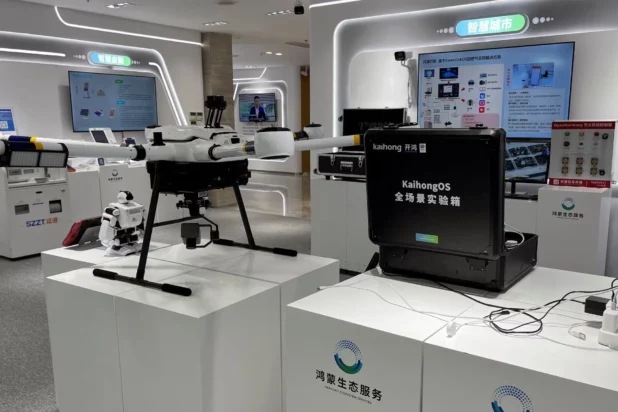It was always going to happen eventually.
China couldn’t possibly continue using American spyware on all of their devices.
Now, finally, it’s happening.
Packed into a small room, a drone, bipedal robot, supermarket checkout and other devices showcase a vision of China’s software future – one where an operating system developed by national champion Huawei has replaced Windows and Android.
The collection is at the Harmony Ecosystem Innovation Centre in the southern city of Shenzhen, a local government-owned entity that encourages authorities, companies and hardware makers to develop software using OpenHarmony, an open-source version of the operating system Huawei launched five years ago after U.S. sanctions cut off support for Google’s Android.
While Huawei’s recent strong-selling smartphone launches have been closely watched for signs of advances in China’s chip supply chain, the company has also quietly built up expertise in sectors crucial to Beijing’s vision of technology self-sufficiency from operating systems to in-vehicle software.
President Xi Jinping last year told the Communist Party’s elite politburo that China must wage a difficult battle to localise operating systems and other technology “as soon as possible” as the U.S. cracks down on exports of advanced chips and other components.
OpenHarmony is now being widely promoted within China as a “national operating system” amid concerns that other major companies could be severed from the Microsoft Windows and Android products upon which many systems rely.
“This strategic move will likely erode the market share of Western operating systems like Android and Windows in China, as local products gain traction,” said Sunny Cheung, an associate fellow at the Jamestown Foundation, a U.S. defence policy group.
In the first quarter of 2024, Huawei’s HarmonyOS, the company’s in-house version of the operating system, surpassed Apple’s iOS to become the second best-selling mobile operating system in China behind Android, research firm Counterpoint said. It has not been launched on smartphones outside China.
Huawei no longer controls OpenHarmony, having gifted its source code to a non-profit called the OpenAtom Foundation in 2020 and 2021, according to an internal memo and other releases.
…
Huawei first unveiled Harmony in August 2019, three months after Washington placed it under trade restrictions over alleged security concerns. Huawei denies its equipment poses a risk.
…
OpenHarmony was the fastest-growing open-source operating system for smart devices last year, with more than 70 organisations contributing to it and more than 460 hardware and software products built across finance, education, aerospace and industry, Huawei said in its 2023 annual report.
Big success story for sanctions too, huh?
So stupid.
I’m already using this shit.
I advise you to get on board immediately.
Huawei Mate X5 with HarmonyOS Next⚡ pic.twitter.com/jsRMV4oe0X
— Kundan Mehta (@Dataflixed) June 24, 2024
Today I experienced the HarmonyOS NEXT pure-blood version of Hongmeng at Huawei headquarters! Very smooth to follow, unified rendering, unified algorithm for the system camera and third-party application camera, use the built-in scan to jump to the corresponding application pic.twitter.com/OB7irXGRWo
— Living In Harmony (@LivingInHM) June 24, 2024
Let’s experience the interruption animation and smoothness of Hongmeng Next. This is still a beta version. I can’t imagine how smooth the official version will be. #Hongmengnext #Hongmeng #Huawei #HDC2024 #HarmonyOSNEXT #HarmonyOS pic.twitter.com/74ctsdDR4r
— Living In Harmony (@LivingInHM) June 22, 2024



